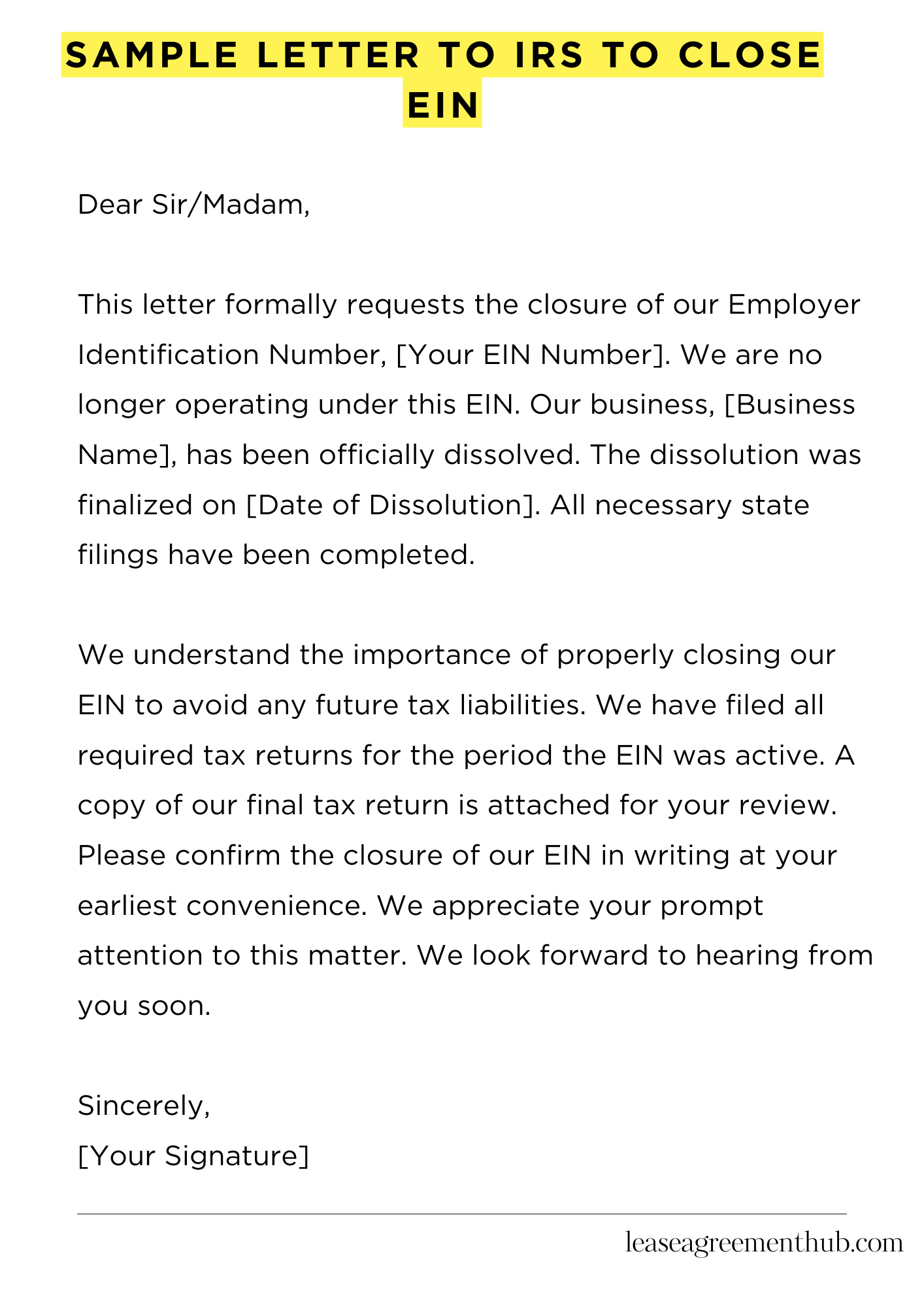Need to close your EIN with the IRS? This means you’re officially dissolving your business entity. You’ll need to submit a formal request.
This article provides sample letters you can use. These are templates to help you write your own letter. We’ll give you several examples.
These samples make the process easier. They cover the key information the IRS needs. You can adapt them to your specific situation.
Sample Letter to IRS to Close EIN
[Your Name]
[Your Address]
[Your Phone Number]
[Your Email Address]
[Date]
Internal Revenue Service
[IRS Address]
Subject: Request to Close Employer Identification Number (EIN) [Your EIN Number]
Dear Sir/Madam,
This letter formally requests the closure of our Employer Identification Number, [Your EIN Number]. We are no longer operating under this EIN. Our business, [Business Name], has been officially dissolved. The dissolution was finalized on [Date of Dissolution]. All necessary state filings have been completed.
We understand the importance of properly closing our EIN to avoid any future tax liabilities. We have filed all required tax returns for the period the EIN was active. A copy of our final tax return is attached for your review.
Please confirm the closure of our EIN in writing at your earliest convenience. We appreciate your prompt attention to this matter. We look forward to hearing from you soon.
Sincerely,
[Your Signature]

How to Write a Sample Letter to IRS to Close EIN
Closing a business’s Employer Identification Number (EIN) is a crucial step in dissolving its legal and tax obligations. A precisely worded letter to the IRS is paramount for ensuring a smooth and expeditious closure. This missive acts as formal notification, initiating the process of deactivating the EIN and preventing any future liabilities. Ignoring this critical step can lead to unnecessary complications.
Understanding the Importance of EIN Closure
An EIN, akin to a social security number for businesses, identifies the entity to the IRS. Maintaining an active EIN for a defunct business can result in misdirected notices, erroneous tax filings, and potential penalties. Closure provides a clean break, safeguarding against future tax issues.
Gathering Necessary Information for Your Letter
Before drafting your letter, collate all pertinent information. This includes the complete legal business name, the assigned EIN, the business address, the reason for closure, and the effective date of closure. Having this data readily available streamlines the writing process.
Structuring Your Letter for Maximum Clarity
Adopt a formal tone and structure your letter clearly. Begin with your business’s name and address, followed by the date and the IRS address. Clearly state your intention to close the EIN in the opening paragraph. Subsequent paragraphs should provide the required information, presented in a concise and logical manner. Avoid ambiguity; clarity is key.
Articulating the Reason for EIN Closure
Specify the reason for closure with precision. Whether it’s dissolution, merger, or cessation of operations, providing a succinct explanation assists the IRS in processing your request efficiently. This elucidation demonstrates transparency and facilitates a smoother closure process.
Including Supporting Documentation (If Applicable)
Certain circumstances, such as mergers or acquisitions, may necessitate supporting documentation. If applicable, include copies of relevant legal documents, like articles of dissolution or merger agreements. Ensure these ancillary materials are clearly labeled and referenced within the body of your letter.
Submitting Your Letter and Following Up
Send your letter via certified mail to ensure proof of delivery. Retain a copy for your records. After a reasonable period, typically a few weeks, follow up with the IRS to confirm receipt and processing of your request. This proactive approach ensures the EIN closure is finalized and prevents any unforeseen issues. Diligence in this final stage provides peace of mind and confirms the successful completion of the process.
FAQs about sample letter to IRS to close EIN
Closing an Employer Identification Number (EIN) requires careful consideration and proper procedure. The following frequently asked questions address common concerns regarding writing a letter to the IRS for EIN closure.
What information is crucial to include in a letter to the IRS requesting EIN closure?
Your letter should clearly state your intent to revoke your EIN. Include your business name, EIN number, the date you wish the EIN to be closed, and your business’s mailing address. It’s also advisable to include a brief explanation for the closure (e.g., business dissolution, merger, etc.). Providing contact information is also essential for the IRS to reach you if necessary.
Is there a specific format the IRS requires for this letter?
While there isn’t a prescribed format, your letter should be professional, concise, and easy to understand. Use formal business letter formatting, including a clear heading with your contact details and the date. Avoid slang or informal language. A simple, straightforward presentation is best.
What if I made a mistake in my EIN application or its related paperwork? How does that affect my closure request?
Any errors in your prior EIN applications should be addressed separately. Contact the IRS directly to rectify those issues before submitting a closure request to avoid delays. Correcting prior errors may involve submitting amended forms or providing additional documentation.
How long does it take for the IRS to process an EIN closure request?
Processing times can vary. While there’s no guaranteed timeframe, it’s advisable to allow sufficient time for the IRS to process your request. You can follow up with the IRS if you haven’t heard back within a reasonable period. Be patient and persistent in your follow up.
What happens after my EIN closure request is processed?
Once the IRS processes your request, your EIN will be officially closed and will no longer be valid. You will no longer be able to use it for tax purposes or any other official filings. The IRS may send confirmation or notification, though this isn’t always the case.
Related: